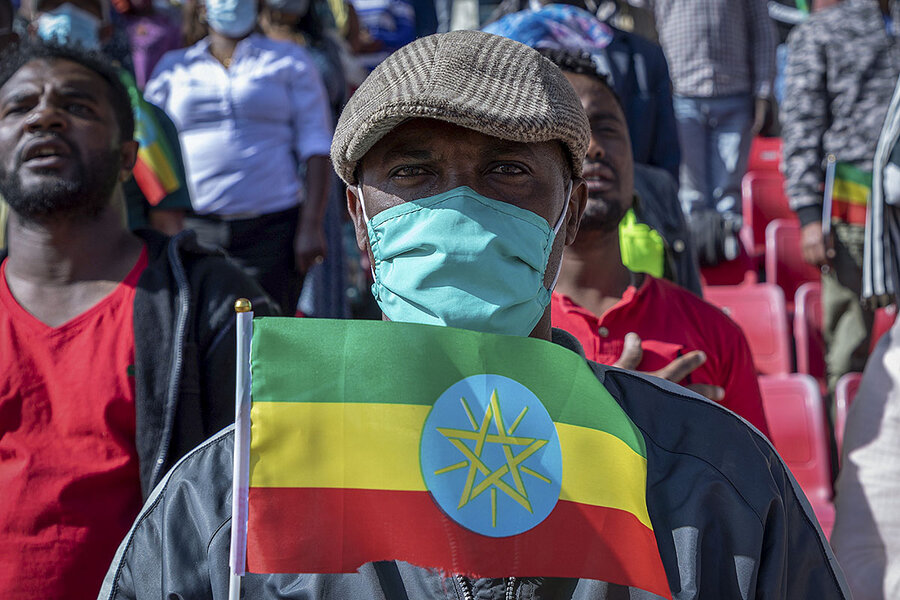Why vision of Ethiopian unity is descending into warfare
Loading...
| Amman, Jordan
In Addis Ababa, a museum in Unity Park stands as a symbol of Prime Minister Abiy Ahmed’s narrative of a modern, united Ethiopia. It includes displays showcasing Indigenous rituals and the three Abrahamic religions’ long history in the country. Others detail the legend of the Queen of Sheba and the shaping of modern Ethiopia by the kings, juntas, and technocrats that ruled in the 20th and 21st centuries.
It is all written in plain language, as if introducing members of Ethiopia’s many ethnic groups to one another. Yet this celebration of Ethiopia’s multicultural heritage is woven into Mr. Abiy’s narrative of one nation-state.
Why We Wrote This
As slogans, national unity and ethnic autonomy both sound compelling. Even uplifting. But in Ethiopia, a young yet ancient nation of many peoples, the evolution of a new identity is bringing them into conflict.
Now, what began as an ambitious campaign to unite and transform the country has escalated into a virtual civil war in the northern Tigray region.
Observers say Mr. Abiy and his allies see the federal system as weakening a nation-state they believe is on its way back to its rightful place as a major player in Africa and the world.
“To do away with ethnic identity is a magic potion for them,” says one Ethiopian observer, requesting anonymity. “If they redo the constitution and outlaw the expression of ethnicity in political form, Ethiopia will return as an empire.”
In mere days, reformist Ethiopian Prime Minister Abiy Ahmed has gone from an internationally acclaimed Nobel Prize-winning peacemaker to a war-leader.
What began as an ambitious campaign to unite and transform the country into a leading African power – by upending a federal system based on regional ethnic autonomy – has escalated from a struggle over national identity to what is bordering on a civil war in Ethiopia’s northern Tigray region.
With reported casualties mounting, the United Nations has warned that the fighting could displace millions.
Why We Wrote This
As slogans, national unity and ethnic autonomy both sound compelling. Even uplifting. But in Ethiopia, a young yet ancient nation of many peoples, the evolution of a new identity is bringing them into conflict.
On one side of the conflict is the federal government led by reformist Mr. Abiy, who came to power with promises of a bold modernization program and was lauded by the international community for finalizing a peace deal with Eritrea.
On the other is the Tigray People’s Liberation Front (TPLF), a former leading political player that crafted Ethiopia’s federal constitution and the multi-cultural ethnic governing coalition that Mr. Abiy is replacing in his push for centralization.
Mr. Abiy announced airstrikes and a ground offensive on the Tigray region this week. But he insists that he is not at war, describing the military offensive as a “law enforcement operation” to bring to justice a “belligerent clique” within Tigrayan leadership.
Unity Park
A symbol of Mr. Abiy’s national narrative stands in Addis Ababa: Unity Park.
At his behest, the government converted former palace grounds of Emperor Menelik II, who forged modern Ethiopia through military conquest, into a public park and museum highlighting Ethiopia’s recent history and its different ethnic, religious, and linguistic groups.
Outside the museum stand cultural displays representing the different ethno-national groups and regions such as the Sidama, the Oromo (Ethiopia’s largest group), the Amhara, the Omo, Somalis, and the Tigrayans, a mostly Christian Orthodox group who make up about 6% of the population but have played an outsized role in politics and the military.
The museum includes displays written in Amharic and English showcasing Indigenous rituals and the three Abrahamic religions’ long history in the country. Others detail the legend of the Queen of Sheba and the shaping of modern Ethiopia by the various kings, emperors, juntas, and technocrats that ruled the country in the 20th and 21st centuries.
It is all written in plain language, as if introducing Ethiopians to one another.
Yet this celebration of Ethiopia’s multicultural heritage is woven into Mr. Abiy’s narrative of one nation-state and one people whose sum is greater than the individual parts, an inevitable shared destiny as a great empire.
Tigray conflict
Triggering the conflict in the Tigray region was the TPLF’s insistence on proceeding with scheduled regional elections in September despite the federal government’s constitutionally controversial decision to suspend national and local elections until 2021. The showdown escalated into clashes between the TPLF and federal forces stationed in the region this week.
The TPLF and other ethnic groups had hoped the elections would serve as a rebuke to Mr. Abiy’s centralized vision for Ethiopia, the second-most populous nation in Africa.
They fear the young prime minister, now without an elected mandate and having suppressed or coopted other regional political movements, will push through constitutional amendments that tilt the country toward a presidential system and reduce local groups’ rights and autonomy.
“If the election had taken place it would have been a referendum on the soul of Ethiopia. Is it one nation-state as one side believes, or is it a multicultural society within a federal arrangement?” says one Ethiopian observer who preferred to remain unnamed due to a wartime crackdown on media.
“I think what is ultimately playing out in this war is the result of two conflicting and contrasting views of the Ethiopian state,” says Awol Allo, a senior lecturer in law at Britain’s Keele University.
“On the one hand you have Abiy’s more unitary, centralized view of the future, where the center becomes the source of authority. On the other you have sub-national governments that demand greater autonomy as secured by the constitution.”
In 1991 Tigrayan leadership overthrew Ethiopia’s Marxist military junta and formed a multicultural governing coalition and the federal constitution, granting autonomy and the right to determination to nine ethno-geographic regions.
They object to the dissolution of the multi-ethnic coalition by Mr. Abiy, a member of the Oromo group who became prime minister in April 2018.
In the months leading up to the conflict, Mr. Abiy increasingly accused the TPLF, the “old guard,” of frustrating his reforms, harboring fugitives, and even inciting inter-ethnic strife across in Ethiopia to undermine his rule.
“Their objective was clear – to make the country ungovernable by instigating clashes along ethnic and religious lines to sow division and discord so that the democratic transition will lose its momentum,” Mr. Abiy said this week.
Observers believe Mr. Abiy sees the conflict as a chance to settle once and for all the struggle between an ethnic federation and a strong central government.
“The TPLF are presented by Abiy’s supporters as anti-reform, as are other ethno-nationalist movements that are at odds with the federal government,” says William Davison, senior Ethiopia analyst for International Crisis Group.
“It is evident that some of those who support the intervention against the TPLF see it as a chance to remove the prime architect of the ethno-nationalist constitutional order and then radically remake it.”
“If Abiy wins, the implication is clear,” says Keele University’s Mr. Allo. “It will be the end of the vision for a decentralized federal Ethiopia.”
National unity
In his two short years in power, Mr. Abiy has met reform benchmarks such as the release of political prisoners, boosting women’s representation in government, and liberalizing the economy.
Yet in each of his initiatives, he has also worked to present a united Ethiopia, one in which every ethno-linguistic group is represented and included, each a component of a greater whole, whose interests are subservient to that of the nation.
It is a tall task for a nation that was formed by the conquering and merging of kingdoms and nation-states in the late 19th and early 20th centuries.
Mr. Abiy’s national narrative is at odds with the various ethno-national groups demanding greater autonomy and rights across the country, and the multicultural federalist constitution in place that grants these groups autonomy and even the right to secede.
“We do not have a shared history or a common past – we all have competing narratives,” Mr. Allo says. “Federalist forces argue that instead of simply forging ahead like the government wishes, let’s construct a new narrative and shared memory for the future.”
According to observers, Mr. Abiy and his allies see the federalist system as weakening a nation-state they believe is on its way back to its rightful place a major player in Africa and the world.
“They think the expression of ethnicity is the source of all evil in Ethiopia,” said one Ethiopian observer, requesting anonymity.
“To do away with ethnic identity is a magic potion for them. If they redo the constitution and outlaw the expression of ethnicity in political form, Ethiopia will return as an empire.”
The TPLF, removed from federal government and confined to the Tigray region, have since emerged as the staunchest defender of regional rights and the status quo.
Fallout
The military confrontation’s fallout could be vast. The TPLF have an estimated 200,000 fighters, and their territory is home to the largest stockpile of Ethiopia’s military equipment and weapons, the third-largest arsenal in all of Africa.
Mr. Abiy has rejected mediation attempts by the U.N., Kenya, and others.
Hundreds of casualties have been reported despite a media and telecommunications blackout in Tigray. Already, several thousand refugees have been driven into Sudan; the U.N. warns 9 million could be displaced.
Others fear the greatest casualty will be the patchwork social fabric Mr. Abiy has gone at great lengths to present as united.
Tensions have flared between Tigrayans and the Amhara people, who hold territorial grievances, with Amhara militias reportedly mobilizing on their regional border with Tigray.
Other ethnic groups may seize the crisis as an opportunity to rise up, including the Oromo, who have grown increasingly disillusioned with Mr. Abiy. Dozens of Ethiopians were killed this July in protests and clashes over the assassination of an Oromo protest musician.
Mr. Abiy continues to push his message of unity and reconciliation – even as his war jeopardizes it.
“I would like to reiterate that no Tigrayan brother or sister should be a victim of identity-based illegal acts,” Mr. Abiy said in a Twitter post Sunday. “And this responsibility lies on all Ethiopians.”










